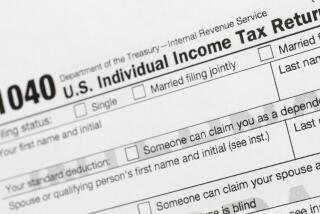IRS Expects Evaders to Cause $127-Billion Collection Gap
- Share via
WASHINGTON — While millions of harried U.S. taxpayers contemplate spending their last weekend before the April 15 deadline honestly computing their federal income tax returns, millions of other Americans have been busy finding ways to evade their legal obligations--by cheating.
The Internal Revenue Service now estimates that the “tax gap” next year--the difference between what Americans, in total, owe and what they actually pay--may surge to as much as $127 billion.
BACKGROUND: That means that taxpayers are voluntarily turning over less than 85 cents out of every dollar that the government believes it should be receiving. And that doesn’t even include revenues not received from other levies such as estate, gift and sales taxes, or from illegal activities.
Since all this money must be made up by honest taxpayers--or borne in the form of added federal debt--the problem of tax evasion is all the more aggravating because most of the cheating is seemingly done by persons who know better and could afford to pay their share.
Authorities attribute more than half the gap to three categories of filers:
Corporations, self-employed people and “sole proprietors”--such as lawyers, car dealers and physicians--and so-called “informal” suppliers, such as street vendors, home repair personnel and many others who seek payment in cash rather than check.
Those who don’t have taxes automatically withheld by employers have the greatest opportunity to cheat--and the least chance of getting caught.
Tax Notes Today, a Virginia-based tax-monitoring publication, offers this profile of a typical tax evader: an upper-income, white-collar male who is single or divorced, younger, college-educated.
“This individual believes in situational honesty (flexible rather than rigid standards) and does not believe that tax evasion is wrong,” the magazine wrote last November.
“He has a low approval of and confidence in the IRS, thinks the tax system is unfair and does not view taxation as the solution to economic problems or does not consider it his responsibility to support the tax system.”
Generally, tax-evaders reduce the amount of taxes that they must pay by exaggerating the value of the deductions they claim--or by failing to report all the income they earn. But surprisingly large numbers of Americans don’t even bother to file returns at all.
In 1987, the latest year for which IRS figures are available, at least $7 billion in federal taxes went unpaid because the government never got returns it expected from more than 4 million people. The number of nonfilers represented a 24% increase from 1985.
It might seem that these people would be primarily the poor, young or uneducated, who conceivably would not understand their responsibility to file a return each year.
But a study by the General Accounting Office shows that 40,000 of these nonfilers earned over $100,000. And the average age of these high-income tax dropouts was 46 years.
One dramatic example of how widespread such cheating has become emerged when the IRS started requiring people who claimed dependents over 5 years old to list their Social Security numbers.
For many households, the difference was dramatic: More than 77,000 filers suddenly reported at least four fewer dependents, and almost 12,000 started claiming at least seven fewer dependents. At least 7 million children and other family members “disappeared” in 1988.
OUTLOOK: An improved computer system should make it easier in the future for the IRS to match the income information it receives on such forms as W-2s against the amount that taxpayers are claiming.
But especially with its enforcement effort under budgetary constraints, voluntary compliance will remain the IRS’ best hope.
More to Read
Inside the business of entertainment
The Wide Shot brings you news, analysis and insights on everything from streaming wars to production — and what it all means for the future.
You may occasionally receive promotional content from the Los Angeles Times.










